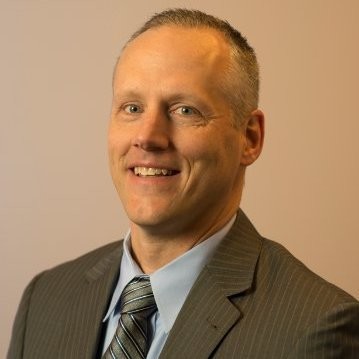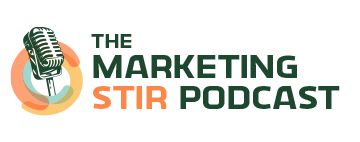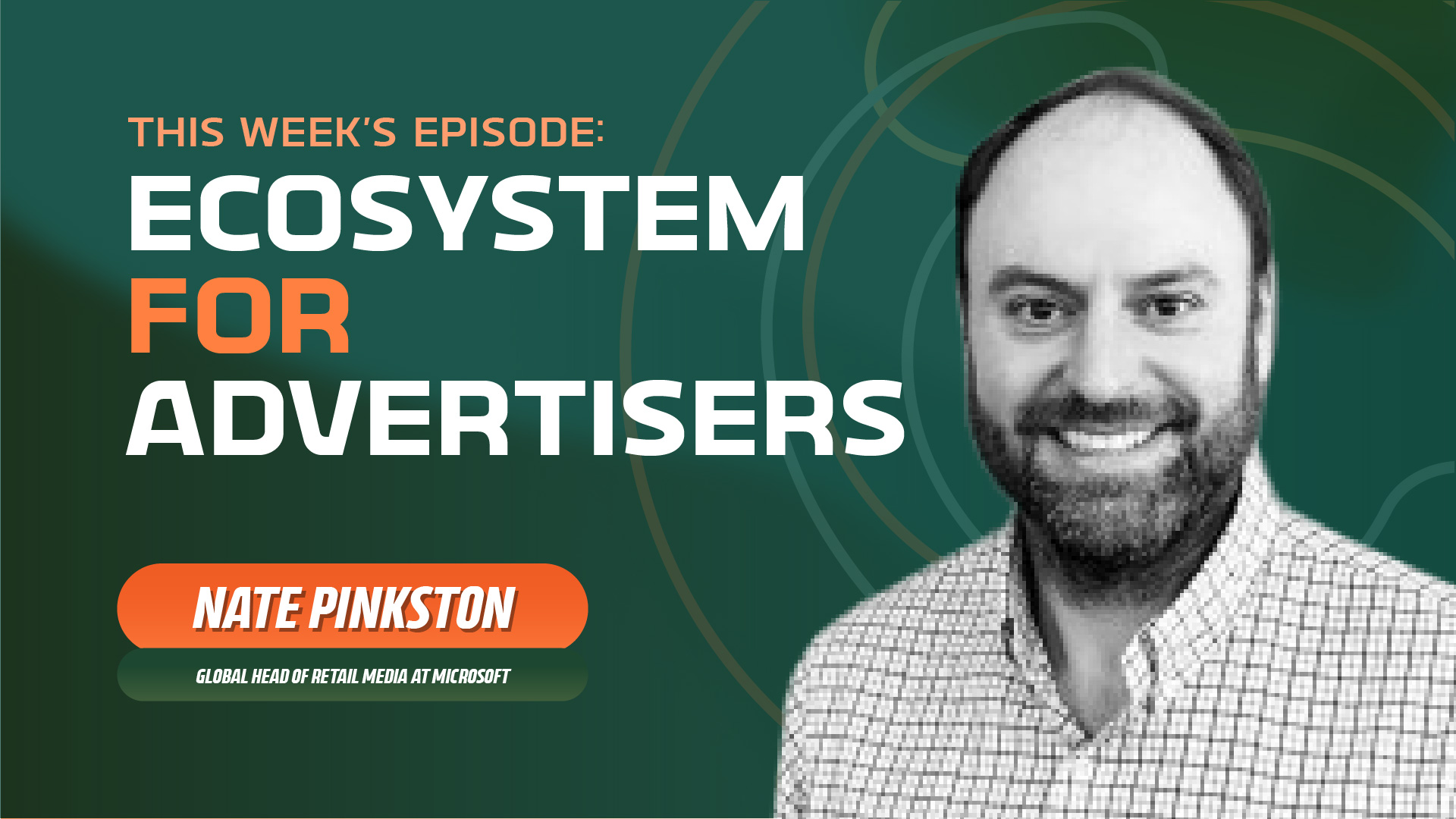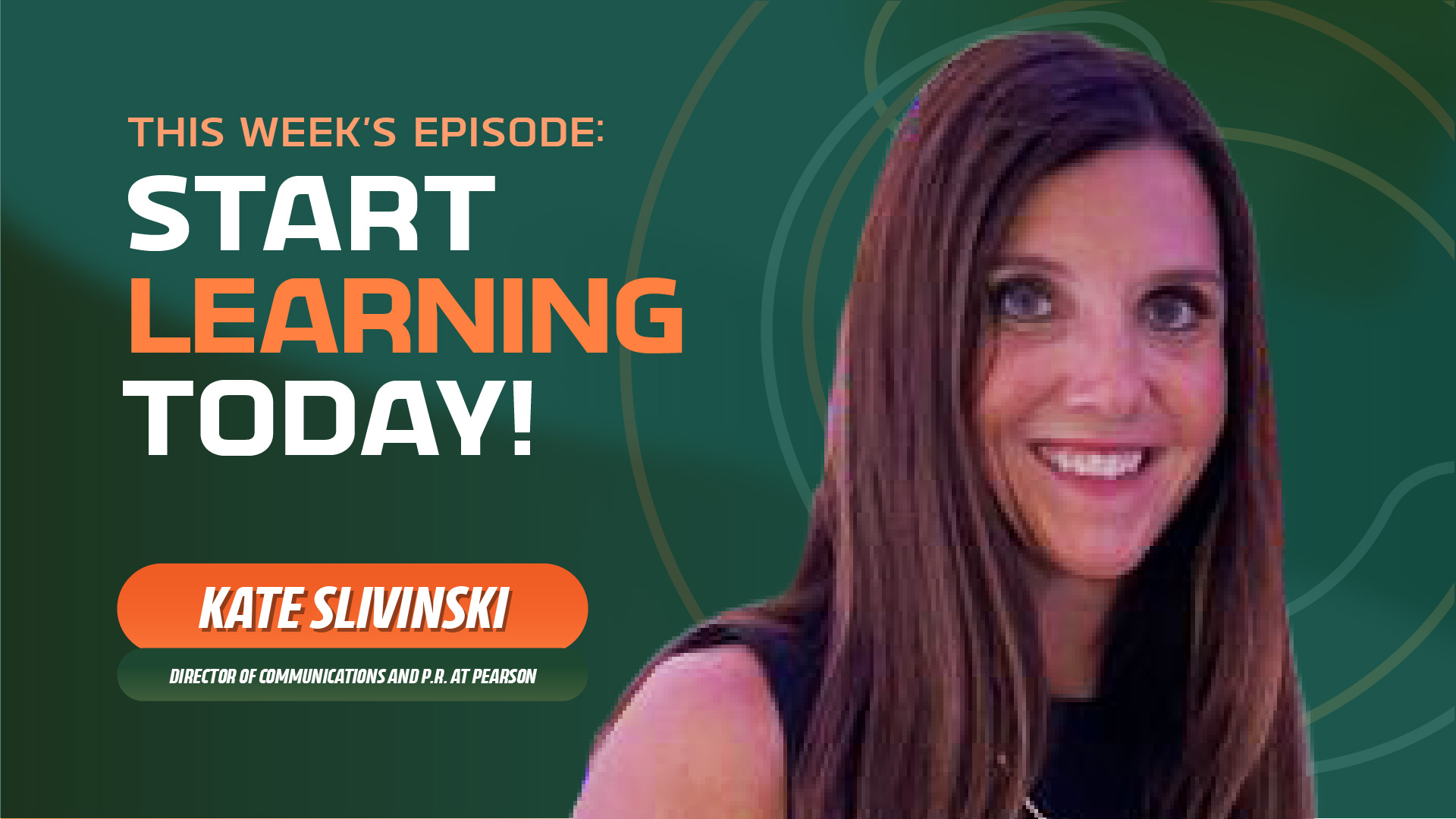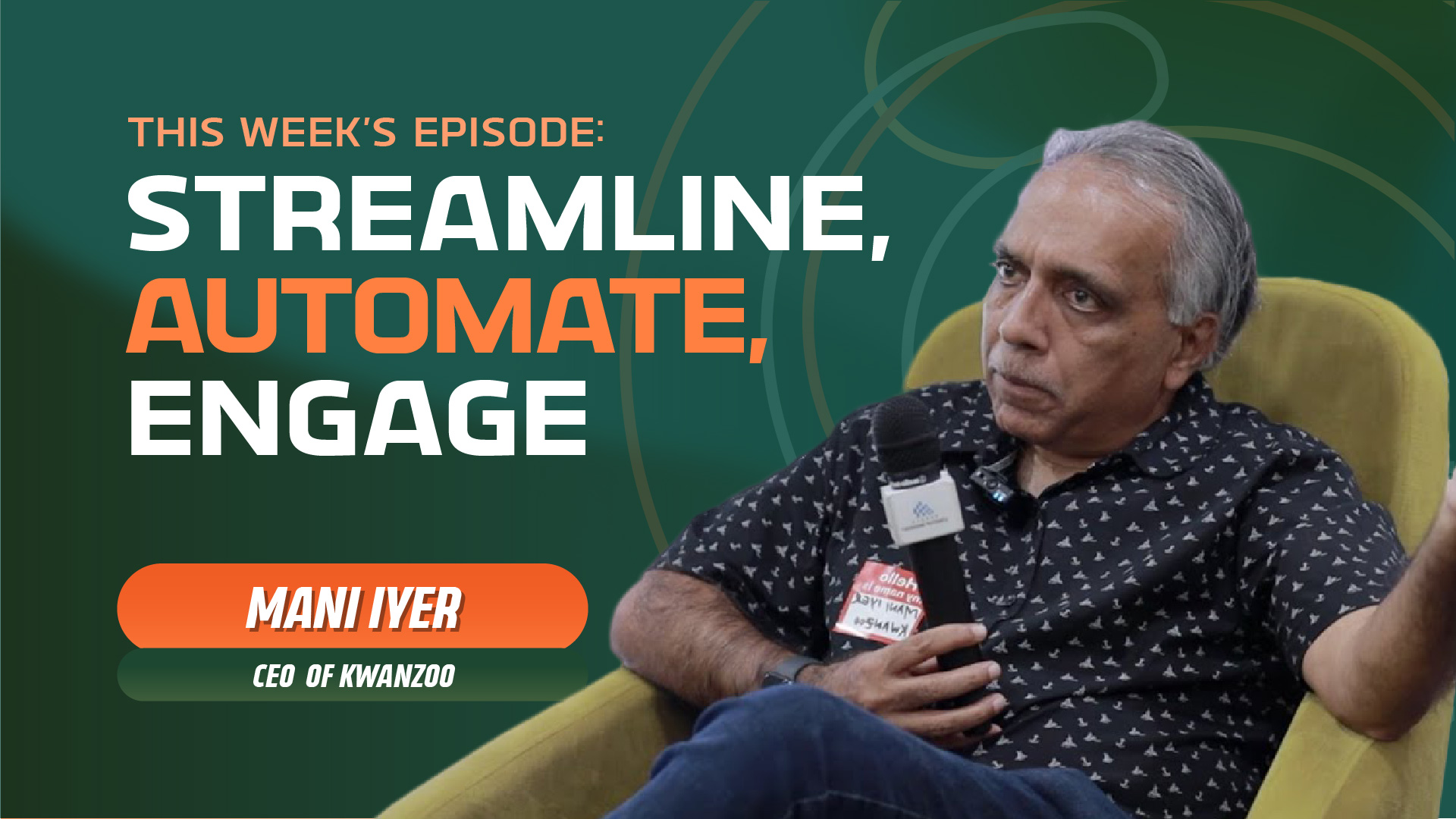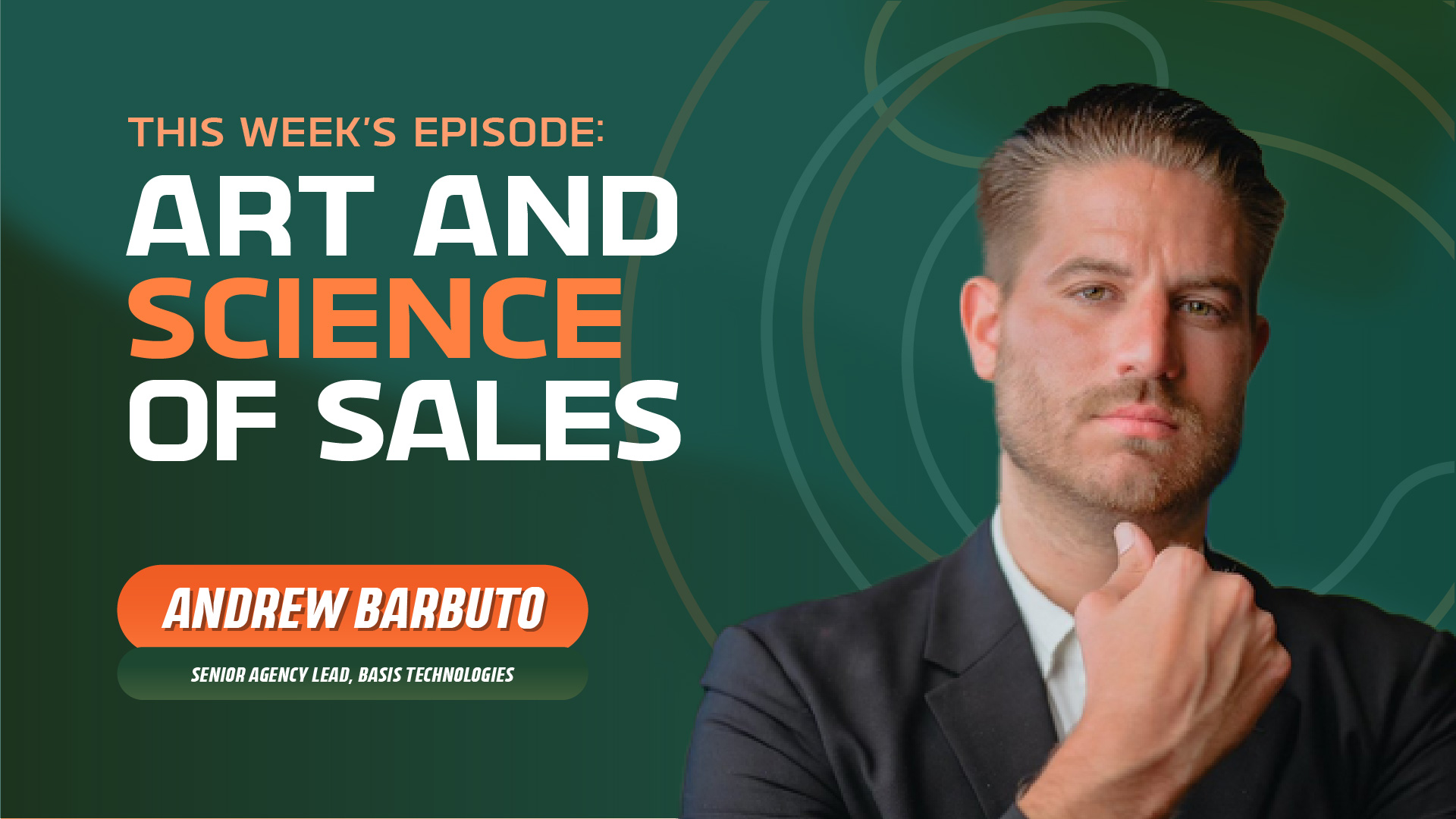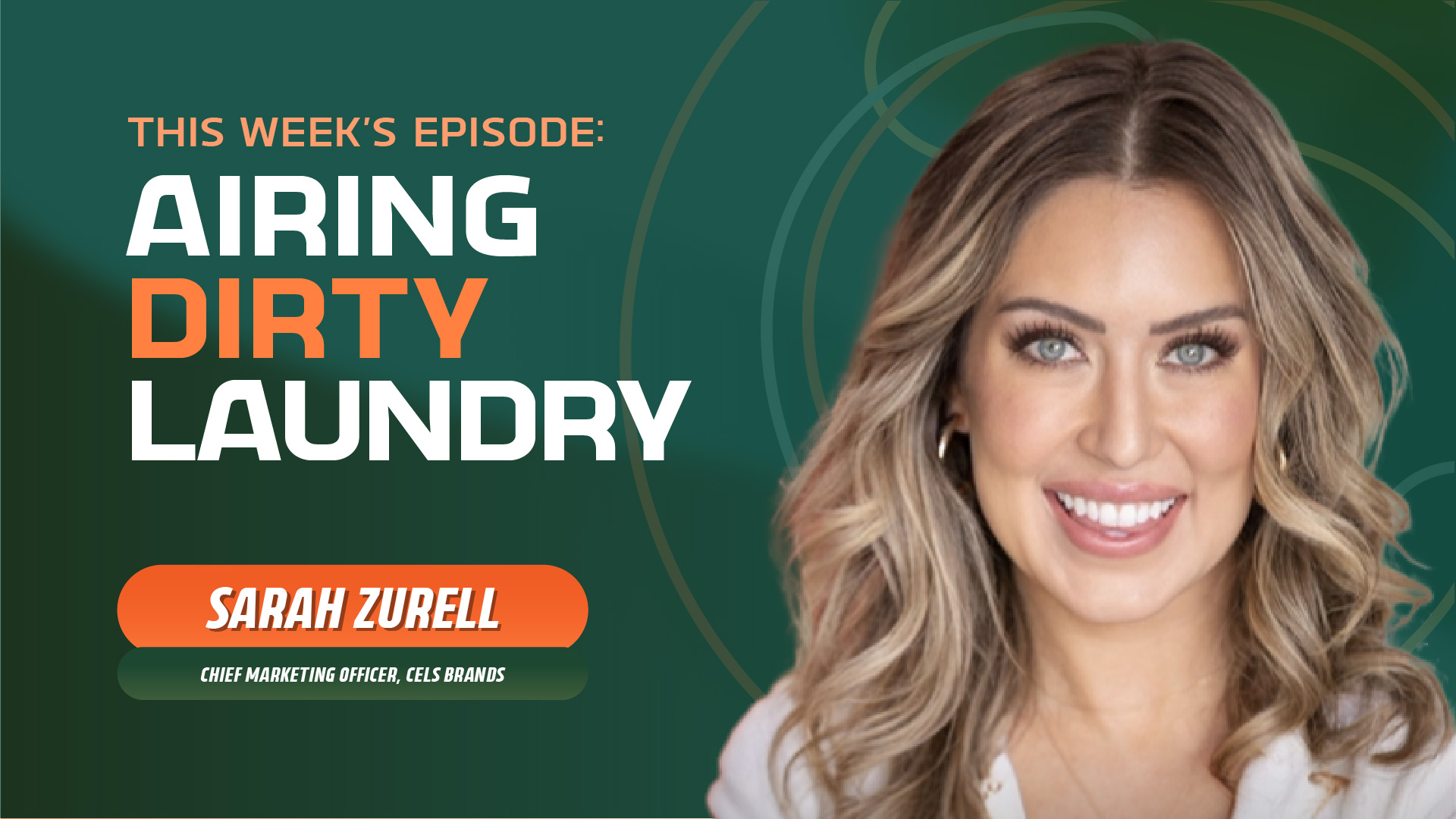Doug Kaczmarek (Moore) - Interim GM of Podcasts
- 0.5
- 1
- 1.25
- 1.5
- 1.75
- 2
Jared Walls: Welcome to The Marketing Stir Podcast by Stirista. Probably the most entertaining marketing podcast you're going to put in your ears. I'm Jared Walls, Associate Producer and Stirista's Creative Copy Manager. The goal of this podcast is to chat with industry leaders to get their take on the current challenges in the market, but also have a little fun along the way. In this episode, Vincent and Ajay catch up with Doug Kaczmarek, Chief Data Officer of Moore. He explores his work as a data scientist before it was called being a" data scientist". He also discusses SimioCloud and how the company leverages consumer data for the nonprofit sector. Ajay feels a little more normal, and Vincent is worried about being called Interim GM. Give it a listen.
Vincent Pietrafesa: Ladies and gentlemen, welcome to an episode of The Marketing Stir. I, of course, am your host, Vincent Pietrafesa, the Vice President of B2B Products and partnerships, Interim GM of Access B2B, that's a funny joke. We'll talk about that later, with my co- host, Ajay. But it is so awesome to be here. Stirista, let's get who we are out of the way really quick. We are an identity marketing company. We have our own B2B data, our own B2C data. Companies utilize us to get new customers. Who doesn't want new customers? We also own our own DSP called AdStir so we can execute that media for you. Connected TV, OTT, that's enough of the acronyms. So great to be here. I'm very excited about this episode, for a number of reasons. But I'm also excited for my co- host, ladies and gentlemen, San Antonio's own, Mr. Ajay Gupta. What's up, Ajay?
Ajay Gupta: Vincent, for the first time on the podcast, I can say it was good seeing you yesterday.
Vincent Pietrafesa: I know. Got to hang with Ajay and a few other people, met new people. Over a year. You see me all the time, you certainly hear from me all the time. I know you're tired of doing that. What's more annoying than hearing and seeing me on video? I guess seeing me in person.
Ajay Gupta: Yeah, it was just good to have some normalcy back in life. Even if I had to see you in person.
Vincent Pietrafesa: Exactly.
Ajay Gupta: I took one for the team.
Vincent Pietrafesa: You did. That's what a lot of people say. My wife said the same thing for seven years now. But it's good to see you people, and normalcy is returning to this podcast. We are in June, that will come out in June- esque, July, but normalcy is returning. It's great. But Interim GM, did you like that comment, Ajay? A recent article came out and it was funny because we've just launched our new Access B2B division, which is all of our B2B data that I, of course, am very involved in, but it's so funny that the article that interviewed you described me as the Interim GM of the whole thing. I was like, oh geez, Interim GM. I said if anyone out there know sports, the interim anything rarely gets the job. But it's cool being Interim GM for a few days.
Ajay Gupta: Tell you what, you can be GM of podcasts.
Vincent Pietrafesa: All right, I'll take it. You see, you know how to make me feel better. That's really what happens is that you know me a long time. I just need a GM title somehow. I like it. But Ajay, let me tell you why I love this next guest. Let me tell you why this is the first for The Marketing Stir. I'll tell you why, this is the first time we've come full circle, not with the same guest, but with the same company. I'll tell you why. Our very first episode was with the CEO of Moore, Gretchen Littlefield, if you remember that episode. That was not video, that was like, hey, let's just put this podcast together and get on an amazing guest and a great company, and let's see what happens. Then we were talking to this next gentleman who's the Chief Data Officer of that company, and we said, this would be great to have him on too. But we said, well, we can't do it back to back. But let's see if this little podcast of ours has any legs. You know what, give us some time, and then we would love to have you on, if we get to that, and we did. We're a person of our word. He's a person of his word as well, and he's on the podcast. He's a friend of Stirista. We like dealing with him, I like dealing with him. Ladies and gentlemen, please welcome to The Marketing Stir, the Chief Data Officer of More, Doug Kaczmarek. What's going on, Doug?
Doug Kaczmarek: Hey, Vincent. Thank you. Very great to be here. Great that I could bring it full circle back to Moore.
Vincent Pietrafesa: I love it. I love it. It's one of those things, you saw the vision, I guess, Doug. I didn't have the vision. I was like, "We're going to do like six episodes of this, and then AJ is going to get tired of hearing my voice." 78 episodes in, and still, we wanted to have you on because A, you believed in us, but Moore's doing some great things, first of all. What a difference a year makes. Always been doing some great things. I've seen some great news out there with SimioCloud, the new division, I'll talk about that, with some of the acquisitions that have just taken place, and just the nonprofit world that you service. We wanted to get to that. But we just like talking to you in general, Doug. It is great to have you back here. For those of the people who don't know, don't know Moore, maybe they discovered the podcast later than the first episode, talk to us about Moore. Talk to us then about your role within Moore.
Doug Kaczmarek: Sure. Moore is a fantastic family of companies that primarily serves the entire nonprofit industry and vertical. Everything from production and envelope production, to agency work, creative work, list planning. We have a brokerage company, media companies that are buying digital media. Then the areas where I'm responsible, CRM and consumer data. A couple of different companies that are managing databases for clients, doing merge, purge work. Just premier technology that's emergent. Then the consumer data company that we built internally is called SimioCloud, as you referenced it. Those three entities that are dealing with data and data at the consumer level, in different ways, with different products and services, to help support nonprofit organizations build their business and build their foundations.
Vincent Pietrafesa: Yeah, now more important than ever, in a lot of the nonprofits out there, working hard to still raise funds. A lot of that landscape has changed, a lot of the in- person... I remember the walks and all that going on. We'll get to that soon. But I always like to follow up with this question is like, how did you get into data? Chief Data Officer, it's one of those very important titles, it's one of those very important roles, but if you go back 10 years ago, Doug, I don't think that title was even around. Tell me about how you got into this business and why data?
Doug Kaczmarek: Sure. It goes all the way back. Being very good at math and sciences, and all that stuff way back. All the way back to grad school and getting a master's in applied statistics, and what the heck am I going to do with this for work, right? Predictive analytics. I had a job opportunity with Abbott Labs, doing pharmaceutical type of statistics, or with Sears and Roebuck in Chicago and doing marketing statistics. Back then, we were called analysts or statisticians and then that sexy title of data scientists didn't come along for decades later. I've been doing it my whole career since the'90s, and started off building predictive solutions to target the Sears credit card customers with either catalogs or offers for credit card protection, or the Pet Club, or the Allstate Motor Club, all that kind of great stuff back in the day. As a practitioner, as a guy, I was in the weeds, building models and coding and programming. The technology's changed over the years, and obviously, the titles have changed. But the concepts are still the same, it's making predictions around what people are going to do when presented with a marketing offer or a fundraising officer, and how do you use data to make those decisions. The techniques are certainly way more sophisticated with machine learning and AI. But all those concepts are the same, and now I'm doing it from the business perspective of pulling together the data, the data engineers, the data scientists and the folks to help sell those products. That's what the SimioCloud business is all about.
Vincent Pietrafesa: Nice. You were cool before it was cool to be in data. I like it.
Doug Kaczmarek: Not so much. The nerds back in the day and really still nerdy now, but certainly people think about data scientists different in today's world. That is kind of cool.
Vincent Pietrafesa: Yeah, I think so. Good ahead, Ajay.
Ajay Gupta: Doug, we've heard about the SimioCloud. We'd love to learn a little bit more about that.
Doug Kaczmarek: Sure. SimioCloud, we started the business about a year and a half ago. At first, we were just internally focused. One of the great things, you mentioned Gretchen Littlefield, when she came on as CEO of Moore, so many of these great companies within Moore, but they weren't connected with data, and they weren't connected with data science. The vision was to build an internal data company, where we could utilize data and data science across those business units more effectively. We started that company with exactly that vision. How do we use consumer data, whether it's just, appending raw data, like email addresses and phone numbers and demographics to a nonprofit organization's data file that we manage for them, or that our agency does work for them, so that they can build better creative, do better targeting. SimioCloud was all about that internal usage first. How do we get our agencies more empowered with data? How can we leverage data into our print shops more effectively? Then, over time, as we licensed more data, and we started thinking about it a little bit more, we decided to go more public with it. Last fall, we launched a product called SimioAudience, which is a cooperative database product that can be consumed by the industry directly to SimioCloud, as well as our internal sister clients can use it as well, of course. How do we help organizations grow their donor base by acquiring new donors, using predictive modeling? That's the big first product. Then the next big product is what we call SimioJourney, which is now that you got a donor, how can you make better decisions? How can you identify those donors on your file that might give you a major gift or become a sustainer, and sign up for that credit card gift once a month for 50 bucks or 100 bucks? All of the movement through the value pyramid, if you will, that's what's SimioJourney, and that's what SimioAudience is all about.
Ajay Gupta: Doug, how did the pandemic affect the many nonprofit organizations that you guys work with, and how have they been utilizing Moore during this time?
Doug Kaczmarek: It's been super interesting. When we were coming up to speed with a lot of our products and services, the pandemic hit. From a modeling and data point of view, there's just been widespread impact across the organizations that we serve. Some in very negative ways. Vincent mentioned earlier, the walks and fun runs and stuff like that. When face to face stuff finished, a lot of organizations were impacted dramatically, and they had to scramble to figure out how they were going to raise money to keep the organization going. For some of our business units, that translated directly into more work. I didn't mention earlier, but we do media buying and strategy planning for donor television. More people are sitting at home watching TV during the pandemic, and that business unit really took off. A lot of our organization, suddenly were redirecting marketing funds from walks to television. Same with direct mail, much more direct mail. Then if you break it down by sector, if you think about the food banks and the rescue missions, they certainly had a huge role to play in helping America over the last year and a half deal with major issues for people. They saw a real big uptick in charitable giving, via direct mail and other channels, and we were there to help them do that. Then certain other organizations suffered as well in different ways. Almost on a client by client basis, in our day- to- day work, we have to break it down and understand how can we use our products and services to best help them? Here's just one quick example, it's almost like we're doing twice the work with predictive models now, because we need to understand who are these donors that are new to the market, if you will, and if we build a predictive model using the more recent data, are we seeing the pandemic effect? If we build a model using data, prior to the pandemic, is it different? We're almost building two different solutions for each client to understand, was that client impacted in a unique way by the pandemic, or is it more of a business as usual? The answer is different client to client. We are seeing major differences for some folks and not for others.
Vincent Pietrafesa: Now, Doug, we talked to some companies that, during the pandemic, digital transformation, they focused on and that was a big thing for them. That particular companies that we had on the podcast, were able to help these businesses that didn't normally do that. Did you see that at Moore as well, with predictive modeling? Like you said, a lot of these fundraising companies, nonprofit organizations, like, hey, we need to do something different. Was there some digital transformation involved, or was there some more predictive modeling come up because of it?
Doug Kaczmarek: Yeah, I think so in a number of different ways. I think, with the pandemic, I think there's a lot of new donors in the marketplace, a lot of them are younger, a lot of them are more likely to transact online. They may have been impacted by an offline type of solicitations, something in direct mail. But instead of filling out a reply device, and mail in a check, they don't even know what checks are, they're going to go to the website, and they're going to donate. Then, you got the classic attribution types of issues. They're not going to put in the source code from a mail piece online, they're just going to make the donation. We've been seeing an uptick in work, and just understanding the cross channel communications and match facts and attribution, and trying to help make better decisions for organizations. How do all the channels work together? How does direct mail work with things they might be doing in social media, or in display advertising, or, as I mentioned, in the donor TV type of work? I don't think it's unique new things, I think it's a continuation of what we've been doing all along, which is just help people measure effectively and market efficiently across all the channels.
Vincent Pietrafesa: During this time, I admittedly didn't know a ton about a lot of the nonprofits out there that dealt with diversity. I discovered all of these different organizations that help different causes. Whether it's race related, inclusivity, and that was eye opening to me, to see all these new nonprofits. But I'd love to hear more about some of that, you guys are shooting at Moore, as far as any of the nonprofits that you're helping there, as well, as, how you're helping donors, just in general understand those concepts.
Doug Kaczmarek: Yeah, sure. It's definitely a big topic in the world, over the last few years, as it should be. As a data nerd, I always attack everything from the data side, and see how we can make a difference. But first and foremost, as an organization, Moore, we are addressing it internally around how we address DEI. But from a data perspective, a consumer database like SimioCloud can really help organizations understand, as their missions are, hey, we should understand the communities for which we serve. Does our donor base match the community that we're serving or not, and what can we do differently? We have all the data down to the individual level, to break it down and build predictive models to help organizations get younger, find younger donors, to find the racial mix that they're looking for. All those types of things we can literally understand what are the proportions of different populations exists within their donor file, and what can we do from a predictive modeling point of view to help them obtain certain goals, or just report on it and give them more business intelligence around it? All those types of issues. I also just think it's interesting, because it's the foundation of what SimioCloud was. The traditional data company model was, you get cooperative data, you get all the donors thrown into one pot from a bunch of different organizations, and then you build models. Well, we started with the entire country, we started with licensed data on every adult American. Our mission from day one was to find new and emerging donors, how can we both accumulate all that donor transaction information but layer it on top of every adult American and then identify people who are going to be aging into, or lifestyle moving into the disposable income that they'll now donate, and find those first time donors really quick, so that we can get them onboarded to organizations quicker. I view the DEI initiatives, as just a different twist on that. We're helping organizations find new people in different ways that hasn't been done before.
Ajay Gupta: inaudible consists of quite a few companies all under the Moore umbrella. How does that play into the data strategy for individual companies? Are you the point person for data across all of the companies within Moore?
Doug Kaczmarek: Yeah, exactly. We help infuse data to the other organizations. As agencies are planning strategy for their clients, we can produce information for them. Business intelligence information, simple reporting around what is the makeup of the donor file, what is the makeup of the prospects that are most likely to respond so that they can think about that, from a creative point of view and a messaging point of view. I think the future there is going to get really interesting where we can use Moore machine learning and AI to help actually influence more of the creative process as we learn what types of messages people respond to, when we build more data on that. But I like the way you put it, I think SimioCloud is the point data company, to push data out to the rest of the organizations, and then ultimately, obviously, to the end user, the end organization. If they want to have their CRM file overlaid with a bunch of characteristics from our database, we can do that as well.
Ajay Gupta: This is more on the personal side, and one of our staple questions, I'm sure with your title, you get a lot of unsolicited emails and LinkedIn messages that come your way. What's an email that gets Doug to respond, and what's one that really annoys you?
Doug Kaczmarek: well, one that annoys me, it's not new, it's been showing up on LinkedIn all the time. But when someone comes to me with claims of automated, turnkey, you can have it in an hour, AI and machine learning type of sales pitch, that just does a disservice to the difficulty that the whole process is. You got to wrangle data, you got to have the right data in place. There are software packages that can churn out a predictive model really fast. But the whole process to gather the right data, boil it into the right type of scenario, consult with a client around what they're trying to do with that model, build the model and then implement the model, that's always going to be much longer than an hour time. I've seen it before, where my internal clients, going back to some of my old jobs well before where I'm at now, the marketer would say, " Hey, I see this software, this company that can do something in an hour, how come you and your team take a couple of days or two weeks to build a solution?" That's because they're not seeing the difficulty it is to wrangle data, build a process and do an implementation. It's very effective in selling. But for someone who's been in the weeds doing very much applied analytics, it gets annoying. The topic of marketing to marketers is always a very interesting thing. That's what I do for a living. I'm often marketing my services to other people who are doing marketing. They can get annoying when people oversimplify the process of what data science is all about.
Vincent Pietrafesa: Yeah, that's definitely a new one. Because a lot of times, that's more of an in- depth answer. A lot of times like, well, you need to get my name right, they think of the simple things. I really care through this time. Well, really, if you really cared, you would have reached out to me months ago. It's that blanket message that I always hate. Doug, talk to me about... Now, this is one of those larger questions where it's like, all right, you've been involved in data, at least what 15 years 20 years, what's changed the most, you think, on how companies are utilizing data, say from your days at Sears, till now?
Doug Kaczmarek: Sure. Well, I think it's dramatically changed many different industries, and I'm not going to be the expert on other industries. But as an observer... Well, first of all, thanks for giving me credit on only 10 to 15 years using data. It's closing in more like 30 at this point. But back in the day, I almost jokingly said, well, what the heck was I going to do with this applied statistics degree? It was the oil and gas industry, pharmaceutical and direct marketing, those were the three big predictive modeling areas. You fast forward to today, and predictive analytics is a part of every industry. It's Moneyball, it's professional sports, it's the algorithms that are underneath Amazon and Netflix. It's in every industry, and if it's not in an industry, then what are they doing, and why are they so far behind? What's changed is the fact that data, and the ability to collect data to be used in industry is now just ubiquitous. Like I said before, what we do in the marketing side is similar to what we did two and a half decades ago, or really, even before I was on the scene, four decades ago. It's just the level of sophistication, and the algorithms that are just so much more advanced now. How you go about it is different. The technologies are different. But the business concept's still the same.
Vincent Pietrafesa: I would imagine security of data has changed tremendously. Was that a huge worry, as you said it, three decades ago?
Doug Kaczmarek: Yeah, not so much. It was harder to break into mainframe systems back in the day, and it seems like cyber attacks and everything else are certainly a major piece, as is the privacy piece. Of course, SimioCloud is, for example, registered with the State of California as a data broker for CCPA and stuff like that. But the locking down of personal information is an important piece. We always like to say this, unlike credit card companies, we don't store sensitive data like credit cards, or social security numbers or anything like that, or HIPAA data. We deal with marketing data. Yes, we have names and addresses. But we lock the data down, because it still is sensitive information on consumers, and it's a non- starter for most organizations these days, if you don't have top notch security, they won't work with you.
Vincent Pietrafesa: Exactly right. That comes up quite a bit in conversation. That's what we love about that everything is here. It's our own platform, it's our own sending. So, yeah, we totally get it. Doug, talk to me about and if you could give some, I don't know if it's secrets, or just some advice for other Chief Data Officers out there listening. First of all, how does the data differentiate between all the business units there at Moore? What's your advice for companies like Moore that just have different business units where they're all needs to be a seamless, one place, if you will, or maybe it's not just one place, where the data sits in stores, and how people could utilize?
Doug Kaczmarek: I think, well, in the first part of your question, the value is in the data. This is a slight different answer to what your question is, but you need to find different sources of data to solve the problems. Algorithms these days, everyone's using the same algorithms for the most part. I say it all the time, the algorithms are more of a commodity. If people say they have machine learning and AI, that's great, everyone's doing very similar things. But you get more juice and you solve the problem better by having unique data sources. Finding companies like Stirista and others to pull together your data set and find where publicly available data is out there, and piecing it all together to have, I would almost say more chances to win. Putting more data into your algorithms gives you more opportunity to find those predictive elements that are going to solve the problem for you. There is information that you can literally find that's free and publicly available. Whether it's information at the geography level, the zip code level, old census data, but newer information that you can aggregate and then information that you can layer on, on top of individuals to make predictions. The type of business problem that we try to solve, whether it's trying to find a major donor, you need to find all kinds of interesting statistics that might be predictive, like literally, how many garage doors do they have in their home? That's probably pretty predictive of someone's wealth and income. You need to have those raw elements flowing in and understand what are the different types of products and solutions you're trying to solve for, and then source the data in the right way. If you've never lived the data, like I have, and you're a Chief Data Officer, you should definitely find someone as the strong right hand that has lived in the data, that can suss out, frankly, from the data sales point of view, what's real about the data and what's not real about the data? I think early on, Vincent, when we were talking, I was grilling you on, well, what is it really that Stirista's offer? What is the data? Send me the data layout. I want to see it.
Vincent Pietrafesa: Yeah, and that's one thing about... Then we appreciate the kind words about Stirista there, Doug. But yeah, that's one of the things that's, here it is, this is what we have. I think we pride ourselves on just being honest company. Our CEO there speaks out on many fraud, anti- fraud panels there. It's there, because security is such a big thing. Because, look, there's other data companies out there. Like you said, the data is a commodity, it's out there. But I think it's the way that you present it, the way that... It's just showing the inaudible I think honesty is the best way, transparency.
Doug Kaczmarek: Yes, definitely.
Ajay Gupta: Doug, like you, I like to get into the data side, and that helps to have a background with the databases to actually see what it looks like, what it feels like. A question for you is, what does your tech stack look like? Is there a preferred software that you use for database management, as well as for analytics?
Doug Kaczmarek: Sure, yeah. We are using Snowflake today, and Microsoft Azure, as the core database. We're coding and building a lot of our own applications using Python, on the data science side to do our predictive analytics. The Snowflake technology, it is wonderful, in terms of ingesting new data files, getting those new data files into the table immediately and available for use within hours. We're talking about moving millions of records around. It's not like traditional data companies, in that you got to load data into certain tables, and then you got to have separate processes to create a unified view of consumers. This is the great example of what has changed in the last 15 years. Being able to ingest data quickly, put it in a table, and then while that's happening, as we're building predictive models for the next client, all that data is now available and ready to go, and it's being used in a matter of hours, if not a day or two. It doesn't take a monthly update to use that information. We can act upon things so much quicker. Then in the direct marketing world, as people who do this for a living know, recency is king, right? Being able to act on a new transaction super quick, just gives you a leg up on the next person to make decisions. What you did last week is much more predictive about what you're going to do the next week. If you have to wait a month to see that data point, you're missing out.
Ajay Gupta: That's a very good point. I remember just five, 10 years ago, when we were all using Microsoft SQL, when you uploaded a large database, first thing you had to build was the indexes, which could take a long time to do. Most of the new cloud databases, you just put it there and it's ready to query.
Doug Kaczmarek: Yes, exactly.
Ajay Gupta: Massive time save.
Doug Kaczmarek: We're working on... This is where I would like to see the nonprofit industry go to more quickly, because I think that the nonprofit industry lags the commercial sectors, in this regard. I would like to see data flowing quicker than what it is. Getting files weekly or daily, we can handle it. But there's still folks using legacy systems and with some of our organizations that we work with, it just doesn't go quick enough. I think that they will catch up, it's just a matter of time and resources on their end. As the technologies become easier, and then we just continue to build more automation on our end. We receive a file, we've seen that file before from a client. Here's the process to just push a button and it's in and it's ready to go.
Ajay Gupta: Doug, what advice do you give to students who might be looking to get into this field, and what are some of the attributes you look for when you're hiring in your department?
Doug Kaczmarek: Definitely. I have interviewed and talked to literally 1000s of folks over the years with titles of analyst, statistician, data scientist. Being able to break down and communicate very effectively the technical terms, what you're doing, and describe it without talking about R squared, or this, that or the other technical statistical terms, is something that I look for. That mix of data scientist and business professional. Not that everyone has to fall into that role. But there's such a need for that type of person in the world today, and I see it all over the place. I've seen, actually companies struggle, because they have really good data scientists that don't understand the business application of what they're doing, and they try to do it by the book, and they miss the mark for what the business person is trying to accomplish. Being able to talk the talk, but also understand the business piece of it puts you better on track. I've seen applications fail, because the data scientist was just much more religious about the textbook solution. At the end of the day, sometimes you need to break statistical assumptions, because it doesn't matter. As long as the business outcome is correct, that's all that really matters. No one's going to pay you money for being correct along the lines of a statistical textbook. But they are going to pay you money if the business application is the right way. Looking for people who understand that and who can translate that and communicate it well, is a very important thing today.
Vincent Pietrafesa: I think you do that very well as the Chief Data Officer. I feel like you could go on business calls, you could be pitching this, and you could be on the sales calls with it. I don't want to say this about all Chief Data Officers, but I've talked to some, where, they're not always as, get that savvy that you said, as far as the business terms, the marketing term, sales terms, especially, all that language. You're saying, be versatile in that sense.
Doug Kaczmarek: Yeah, for sure. I definitely... Maybe this is probably an unfair answer I gave you, Ajay, because that's what I've modeled my own career after. I was in the weeds doing the analytic stuff. But I've made a career out of being able to explain things. Gretchen Littlefield has teased me relentlessly lately about how I'm a good salesperson, and I never wanted to be in sales, but it's like leading the initiatives here. There is obviously a lot of sales aspects to what I do. But I also love visiting clients in all my prior roles, and prior companies, and talking to clients about what they do, and have felt very comfortable really starting off and almost like interview style to the client, what are you trying to accomplish? What's the information that you have today? What would a success look like for you? Then taking what I know about data and analytics and what we have available, and matching it to that problem. That's where it's a technical sale. That's what it is, and if we don't have an off the shelf solution, then thinking quickly about how we could build a solution to help apply it on the fly.
Vincent Pietrafesa: It's a great skill to have. He is not our Chief Data Officer by title but we have blamed Britain. I love bringing Blaine on calls because I do understand data and the aspects of it. I think I do a good job of matching in the right partnerships together that way, with Stirista and my client, which I hope so, I've been in this business 20 years, but I always like... I don't always get some of the nitty gritty of the data. Ajay said stuff before about SQL and index, you lost me. I fell asleep for three minutes about that. But I know it's vital and it's important and Blaine does that for us. He has that as well. No, that's a great quality to have. Doug, let's get into some personal stuff here. I know this value from talking to you. We've actually never met in person, you and I. Hopefully, we'll change that in the future, now. That again, we started the podcast talking about things are opening up again. But for people who don't know this about you, you're 6'6", you played basketball in college, a darn good basketball player. Tell me about that. Tell me what your days in college there playing. Do you still play? What are some of your hobbies, interests out there?
Doug Kaczmarek: Sure. I wish I could still play basketball. In my mind, I can, but the reality is the knees and the back don't allow for it, anymore. I used to love to play and then being so tall, I got into playing volleyball as well. That was fun. Love to play golf, which, when you're as tall as I am, there's a lot more moving parts to the swing. That can get a little crazy too, inaudible people everywhere. Then, from the competitive side, and the numbers side, I grew up in the Midwest playing cards with family members on holidays and stuff like that, and then got into playing poker. There's definitely a lot of math, a lot of psychology. Plus just the interaction, being more left brain. That's really helped learning and understanding the psychology and how other people think. Love to play competitive poker and you talked about going to Vegas and looking forward to doing that again soon down the road and playing some more poker tournaments and getting back to the real world. I'm getting on an airplane tomorrow for the first time myself for business purposes. Looking forward to that too.
Vincent Pietrafesa: Nice. I know it's not New York because you would have let me know.
Doug Kaczmarek: No, it's not.
Vincent Pietrafesa: I was going to say, " We got to bring Doug down to Vegas. I think we found our next person to come with us." That's awesome.
Ajay Gupta: It's funny you mentioned the height, Vincent, because just in the last two, three weeks, I'm starting to actually meet people we have hired in the last year, and it's just funny, you can't really tell height on Zoom. There's some people-
Vincent Pietrafesa: There's people where you think like, wow, this person must be 6'8", and they're like, okay, 5'4", all right. That's fine. Hey, you never know, 5'6"-
Doug Kaczmarek: That's the surface level. I probably should have brought that up when we talked about the pandemic. We built this whole SimioCloud company, pretty much during the pandemic. I think I'd only hired a few people before that. It's a whole new world out there from the business point of view. You're meeting for the first time people that you've hired and people that you've been working with, and keeping employees and everyone motivated, and together, and that sense of togetherness on what a mission is behind a company is pretty challenging these days.
Vincent Pietrafesa: Yeah, definitely. But it seems like companies are doing the best they can to do that. It is nice, as Ajay said. We started, again, the podcast, we're just seeing people, a few of us are getting together here in New York City this week just to meet. I'm meeting one of my interns for the first time. It's crazy. Then we're going out to San Antonio to get together to do some strategy for the rest of the year and next year, and just great to see people I haven't seen and I've only been with the company two years, but I haven't seen them in all this time. This is great, Doug. I can't wait to meet you in person, sir. Thank you again, for doing this and spending some time and look, a lot of nonprofit organizations listen to this podcast. We constantly talk about nonprofit organizations. Ajay is heavily involved with some. My favorite nonprofit organization is St. Judes. I am an avid donor to St. Jude. If you're listening, SimioCloud, Moore, reach out to Doug Kaczmarek. Doug, this has been a pleasure. That's Doug Kaczmarek, the Chief Data Officer of Moore. I'm Vincent Pietrafesa. That's Ajay Gupta. Can't get enough of him. See him next week as well. This has been another episode of The Marketing Stir. Thanks and have a great day.
Jared Walls: Thanks for listening to The Marketing Stir Podcast by Stirista. Please like, rate and subscribe. If you're interested in being a guest on the podcast, email us at themarketingstir @ stirista. com. Thanks for listening.
DESCRIPTION
Doug Kaczmarek, Chief Data Officer at Moore, explores his work as a data scientist before it was called being a “data scientist.” He also discusses SimioCloud and how the company leverages consumer data for the nonprofit sector. Ajay feels a little more normal, and Vincent is worried about being called interim GM.
Today's Host
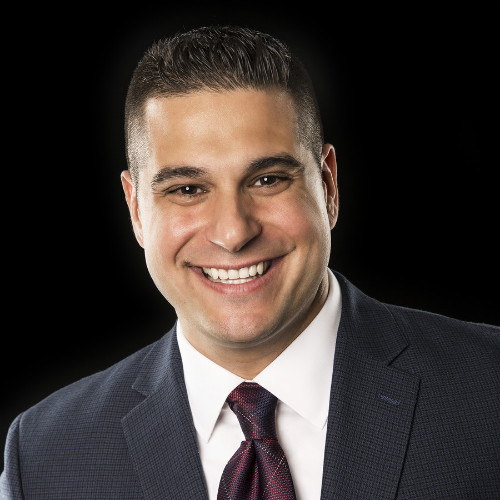
Vincent Pietrafesa

Ajay Gupta
Today's Guests
